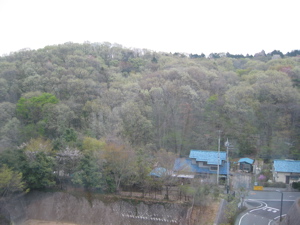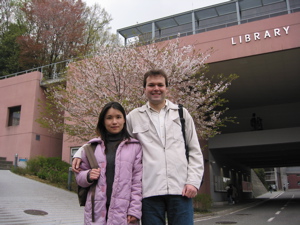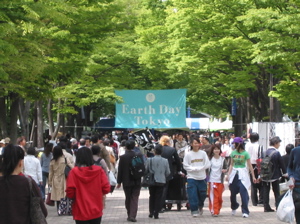April 25th 2005
Life in Tokyo is finally settling down into something of a standard routine. Last week I got a lot of work done, as well as reading and some shopping. I'm now a real Tokyo resident, as I have a Passnet card (non-JR railways) and a Suica card (JR railways). I've got through a 5000 yen ($50) passnet card in a little over three weeks, though, so I may need to reduce the amount of travelling I do.
Last weekend, on the 16th, there was an art exhibition at Yuriko's old university, showing work by a couple of people she was still in touch with. It was ten years since she'd been back, so she was quite keen to go, and I was interested to see the place. Hana, another of Yuriko's friends from university, also came.
 Rural Tokyo.
Rural Tokyo.
The university, Tokyo Zokei University, is in Aihara. Aihara is in the Tama area of Tokyo, which is very different from the standard image. Tokyo is, broadly, divided into two areas. First, there are the 23 Ku. These include Ota-ku, where I live, and such places as Shinjuku-ku and Shibuya-ku, the busy city areas with skyscrapers. Then, there is the Tama region, with the Shi, or cities. There are big cities there, such as, according to Yuriko, Hachioji, but there are also rural areas.
Yes, 'rural Tokyo' is a real place.
It reminded me a bit of the Peak District, except that the hills here are still largely wooded. It's also an easy day trip from Tokyo, so we may well visit that area again in the future.
Zokei is quite a new university, less than forty years old, and the main buildings are quite striking. That is only proper, as it is an art and design university. Yuriko studied environmental design, which covers everything from the arrangement of furniture in a room to the arrangement of towns in a country.
 Me and Yuriko at Tokyo Zokei University.
Me and Yuriko at Tokyo Zokei University.
We did visit the exhibition, but we spent a lot of time just walking around the university, while Yuriko and Hana repeatedly said "natsukashii!".
"Natsukashii" is one of those words that is very common in Japanese and does not translate well. It's an adjective, but like most Japanese adjectives it applies both to the person having a feeling and to things that arouse a feeling. That is, 'frightening' and 'frightened' are the same word in Japanese, which occasionally leads Japanese people speaking English to say things like. "I'm boring. What shall we do?".
Anyway, 'natsukashii' is used when something evokes positive memories of the past. 'Nostalgic' is probably closest, but the implication that you are ignoring the present doesn't seem to be there. In addition, you can't, I think, get lost in natuskashisa the way that you can in nostalgia. It's also much more broadly used.
We had lunch in the university canteen ("natsukashii!"), which was pretty good by university canteen standards (that is, it wasn't actively unpleasant), looked around a block of classrooms ("natsukashii!"), went to the museum to look at the exhibition ("natsukashii!"), went to the coffee room over the professors' offices, which is where I took the photo from ("natsukashii!"), and looked around the workshops for sculptors and the like round the back ("natsukashii!"). The workshops were a bit eerie, because there were parts of rejected works lying around. Parts like heads, arms, and torsos...
Anyway, by the end of the day I was teasing the two of them about everything being natsukashii, and they made a (failed) effort to find other words to describe what they were feeling.
Last week I managed to settle into a bit of a routine for getting my work done, and actually made the progress I was planning to. Things were slightly thrown when I failed to get internet in my room on Tuesday. The workmen came, but apparently it isn't possible to put an individual connection in now and then upgrade to a flat-type connection for the whole block, so I have to wait for the landlord to get everything installed.
On Thursday, I had a preliminary meeting with a potential English student, and then went to Shinjuku to do a bit of shopping. I needed a background book for my next writing project, and the company in question hadn't shipped it to me. Unfortunately, said company does Japanese translations of its books, and those are the only ones you can buy easily in Japan. I could read the Japanese translation, but it would slow things down quite a lot. Thus, I sent an email to the company asking them to please send me the English book. That will hold up that bit of work for a while, because I can't do anything until I have, and have read, the book, but I have other freelancing to be getting on with.
I did buy a couple of books, though, because they were on sale and thus cheaper than getting them from Amazon.com, which is not normally the case.

On Saturday, Yuriko and I went to Earth Day Tokyo, in Yoyogi Park. This was fascinating, because it was exactly like similar events in Europe. Well, apart from having lots of Japanese people and things in Japanese, of course. There were lots of stalls selling 'ethnic' goods, such as T-shirts with (English) messages from the Dalai Lama on. There were stands for various charities, such as Friends of the Earth. There were fortune-telling stands and 'Legalise Cannabis' stands. There's no real reason why all these things should go together, other than a historical accident of culture in Europe and America, so it's rather bizarre that they are found together even in Tokyo.
Yesterday was my first Ars Magica session in Japan, and it was fun. The troupe are a shining example to all other troupes: every single player has their own copy of the rules. (There is one female member, Yoko Miyamoto, the storyguide, but otherwise the standard gender bias of roleplaying applies.) We are playing Calebais: The Broken Covenant.
Normally, players are encouraged not to read the scenario in advance. This is tricky when you edited it. As a result, I'm playing grogs (guards for the other characters), so that I won't be expected to make executive decisions or have any useful input to discussions. That makes it rather easier to pretend I don't know anything, because I don't have to work out what I would have thought had I not read the scenario in advance.
Just like Earth Day, the session was exactly like a session in England, apart from being in Japanese. We started, and the player characters immediately started faffing around missing the point. After about five hours of faffing (seriously), we left the covenant, and promptly screwed up a simple operation.
In Ars Magica, most wizards are deeply disturbing to meet, no matter how nice they are; it's a side-effect of their ability to work magic. Since the scenario starts with a visit to a mundane village, we had split the party to send non-disturbing people to talk to the villagers while the rest of us waited. (This showed a remarkable level of foresight. Sending Hadrianus, a character with a tendency to get involved in romantic problems was less clever, but that's a separate issue. He's the only magus who doesn't bother people, so he was the bestleast bad choice.)
The magi (wizards) decided to try to use magic to establish communication between the two groups. The first stage involved our shapechanger (Lupus) changing into a crow and taking an object that would link the two groups to the group in the village. (Of course no-one thought to hand it over before we split up.) That worked. Unfortunately, he botched the spell and is currently stuck as a crow.
Anyway, another magus (Sonns) then tried to alert Hadrianus to the nature of the linking object. He pulled out all the stops, and that worked. Then they calculated the level of the spell they needed to actually communicate that way, and discovered that it was far, far beyond what they were capable of. Note the order of actions here. Put lots of effort into setting something up, and then work out whether you can do it.
Yes, exactly like back home.
Natsukashii!